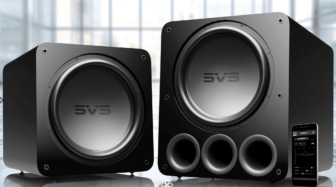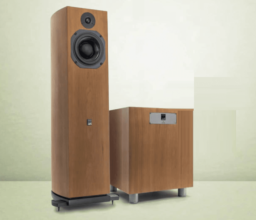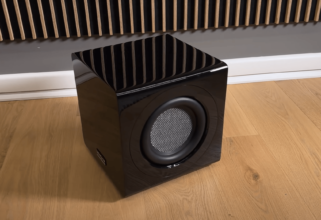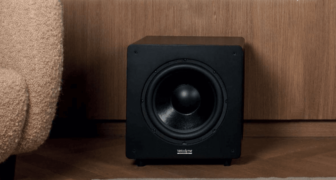KLIPSCH SPL-150 Review – American muscle, value for money
Klipsch’s SPL-150 subwoofer is certainly big, but is it clever? And does that really matter when this bass beast sells for just £? Richard Stevenson investigates. Read our KLIPSCH SPL-150 Review.
HOLD THE PHONE, is that a 15in subwoofer with a 400W amplifier for less than £? I believe it is, and quickly scrolling to the SPL-150’s entry on Klipsch’s website leaves little room for product positioning ambiguity. Under the heading ‘Badass Bass’, is the statement: ‘We’ve been pissing off your neighbours since 1946 – why stop now?’
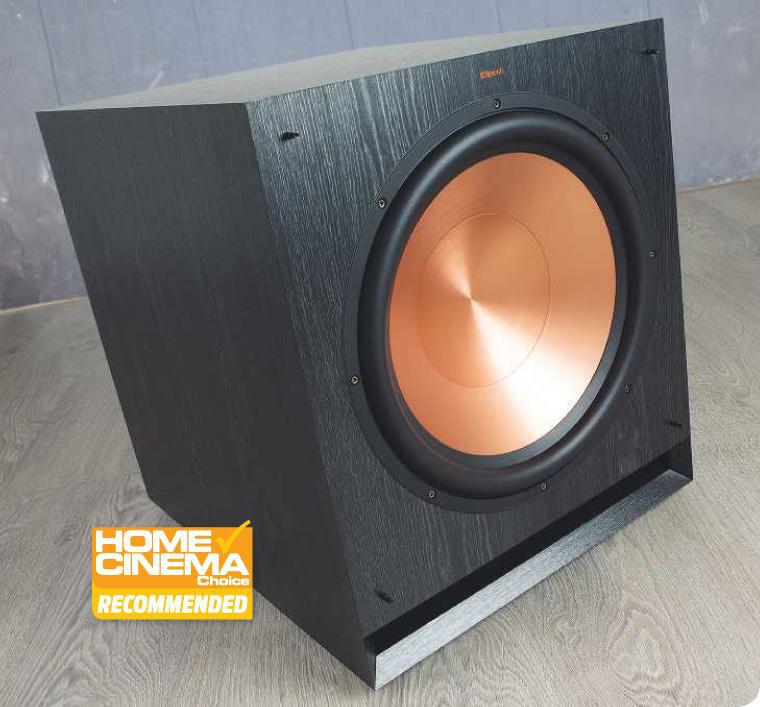
POSITION: Top of the three- strong SPL range
PEERS: PSB SubSeries 350; B&W ASW610XP; Monitor Audio Silver W12
I love it already.
In an effort to deliver maximum bass-bang per buck, Klipsch’s SPL series eschews fancy finishes and frivolous features in favour of big drivers, big amps and big, slot-ported boxes. The flagship reviewed here comes in at a whopping half-a-metre or more on every dimension, and its design makes no apologies for its 15in driver by giving it a stand-out copper colour finish. Should the look prove too much for your sensibilities you can tame it with a supplied grille. It wants to be seen.
This is Klipsch’s largest ‘Cerametallic’ driver, with a long-throw coil and bulbous rubber roll surround. We’re told the cone is remarkably light but very rigid, with exceptional LF response and very low distortion – but I’m yet to hear a subwoofer driver described in any other way.
While the metallic copper finish is eye-catching, should the look prove too much for your visual sensibilities you can tame it with a supplied grille. The steel mounting posts are on the cabinet and not the grille, and hence stick out if the grille is not fitted, which is a little odd.
The cabinet is a square-edged cube wrapped in ebony black wood-effect vinyl, with a front-facing slot port for bass-loading rather than a traditional tuned tube.
A slot port can reduce the port chuffing associated with a tube, and front-facing ports make a subwoofer easier to place in corners or near a back wall. The reason few subwoofer manufacturers opt for slot porting is that they are trickier to tune to specific frequencies, and the larger opening area can lead to a bit of gung-ho boom and bloom deep down.
Inside, there’s a Class D amplifier rated at 400W RMS and 800W peak. Combined with the high-efficiency driver and voluminous cabinet, the SPL-150 is said to hit 122dB. Gulp.
Back panel controls, handily positioned near the top, are knobs for gain and variable low-pass, and switches for 0/180-degree phase and on/off/auto power. Connections are just line-level inputs and a DIN-port for the optional Klipsch WA-2 wireless kit, which will set you back £.
Loop throughs, balanced connections, EQ systems or even a remote control are conspicuous by their absence, although many other sub-£ woofers (and more expensive ones) don’t offer these either.
Positioning the SPL-150 is not the charade it could have been. Its relatively bijou 34kg makes it fairly easy to move around, and the rubber isolating feet soak up small flooring imperfections to stop it wobbling. The front port gives you a lot of confidence in backing it up to a wall too, making it a versatile woofer in terms of where you can put it.
Klipsch recommends corner placement to make use of the added boundary gain, and for the ultimate in-room LFE compression suggests one SPL-150 in each corner, run simultaneously through four WA-2 wireless kits. That would leave you lighter to the tune of around £ and very probably deaf by Christmas. I like the idea though.
Gordon’s alive!
Getting the LFE level right was equally straightforward after I abandoned using the rather coarse onboard low-pass filter. With bass management duties assigned to my AVR and the level knob set mid-way, the SPL-150 was ready to rock. ‘For god sake, strap yourselves in!’ I mused when I slipped the Blu-ray of Flash Gordon into the deck for some high-camp, low-frequency fun.
My death-grip on the sofa arms, anticipating an uncontrolled assault of woolly LFE, transpired to be misplaced. Dialled in to the rest of the system, the SPL-150 neatly underpinned the thumping Queen soundtrack and did nothing to slow the infectious rhythm of Football Fight. While Klipsch’s SPL models are never going to bag awards for being neutral and understated, I was pleasantly surprised how well this flagship sub rocked along to the film’s aged score without turning it into a boom-a-thon.
Nudging up the volume, the Hawkman vs Ajax scene is a pure smile-fest, combining ridiculous sound effects, spectacular visuals and Bryan May wringing every last note out of his guitar. Brian Blessed’s dialogue benefits from the sub’s weight. The Klipsch keeps the pace well, backs up the fire-fight and does a reasonable job of turning the kitsch explosion of the Ajax into an almost modern LFE triumph.
For something altogether more high brow than Ming the Merciless’s high brows, 2004’s House of Flying Daggers continued the colourful cult movie theme. Thrown pebbles and drums – you know the scene – had the SPL-150’s copper cone in a visible state of flux, reaching a fair way into its throw range with the volume cranked right up.
There was no shortage of room-filling output, but the initial drum attack did lack the visceral feel of faster subwoofers and there was some smearing of the drum’s overall tone.
Boom boom shake shake the room
The SPL-150 is a fabulous concept in delivering big subwoofer bass at levels your mother would disapprove of, and for a relatively affordable outlay. Its lightweight cabinet is perhaps its weakest link, adding its own take on the overall sound, so it’s not a sub for those in search of razor-sharp edges to LFE transients. But it’s cracking value for money nonetheless, and lots of fun
1.15in too big for you? The SPL series also features 10in and 12in models
SPECIFICATIONS
DRIVERS: 1 x 15in spun Cerametallic copper finish woofer ENCLOSURE: Front slot-ported ONBOARD POWER (CLAIMED): 400W FREQ. RESPONSE (CLAIMED): 18Hz-125Hz REMOTE CONTROL: No DIMENSIONS: 495(w) x 546(h) x 566(d)mm WEIGHT: 34.2kg
FEATURES: LFE/stereo line-level inputs; WA-2 wireless kit input; simultaneous wired/wireless connection; variable low-pass filter; switchable 180-degree phase control; auto power on
PARTNER WITH
KLIPSCH R-620F: Sporting the same copper/black aesthetic as the SPL-150, this Tractrix tweeter floorstander is a great starting point when building a multichannel Klipsch system. Easy to drive, with a thrillingly powerful and dynamic delivery.
Verdict
When you purchase through links on our site, I may earn an affiliate commission. Here’s how it works.
LABORATORY TEST REPORT
Newport Test Labs first measured the frequency response of the Klipsch SPL-150 using a near-field technique that removes room-related effects, effectively obtaining the same response that would be measured in an anechoic chamber. This technique requires that the output of the bass driver be measured separately from that of the bass-reflex port, which is the reason for the two traces shown on Graph 1.
The black trace on Graph 1 shows the frequency response of the SPL-150’s bass driver when the crossover control is set to approximately ‘half past 10’, which the lab reported was the setting that gave the ‘flattest’ response when conducting this test. You can see that the response is within ±3dB from around 23Hz up to 90Hz, which is an excellent result.
The red trace shows the output of the front-firing bass reflex port and you can see that it peaks at around 18-19Hz and rolls off very smoothly either side, so that its output could be characterised as 14-28Hz ±3dB.
Klipsch’s engineers have done a very good job on this, because you can see that the output of the bass reflex port starts rolling off above 20Hz and the output of the bass driver starts rolling off below 30Hz, with the two traces crossing approximately midway. This means that the outputs of the two would sum complementarily across this bandwidth such that the overall combined response would be approximately 14Hz to 90Hz ±3dB. (I note that Klipsch claims 18Hz to 125Hz, but since it doesn’t mention the dB level variation across this range, I can’t speculate on any differences between Newport Test Labs’ measured results and Klipsch’s specifications).
Graph 2 shows the room response of the Klipsch SPL-150, measured at a distance of three metres using pink noise. This time, the black trace shows the frequency response of the SPL-150 when the crossover is set to maximum and the blue trace shows the response when it’s set to its minimum. You can see that set to minimum, the response extends from around 13Hz to 50Hz ±3dB. The maximum setting shows a frequency response of 16Hz to 180Hz±3dB, but at the expense of a bit of a peak in the response centred at around 90-100Hz. Backing off on the crossover a bit would flatten this response out, but would also truncate the extension somewhat, so it would be closer to Klipsch’s specification, leading me to guess that the company is probably stating a room response with a ±3dB window for its published spec.
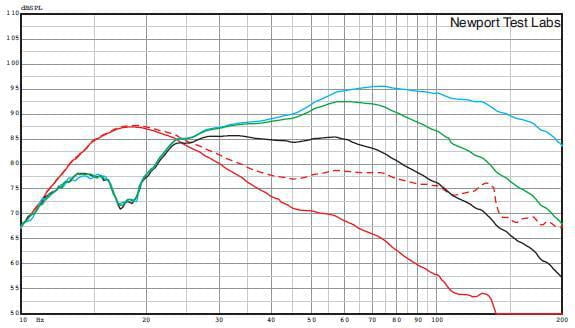
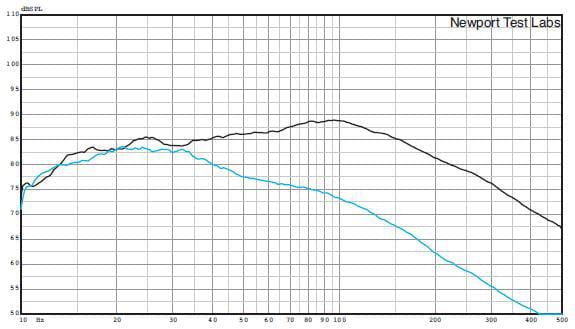
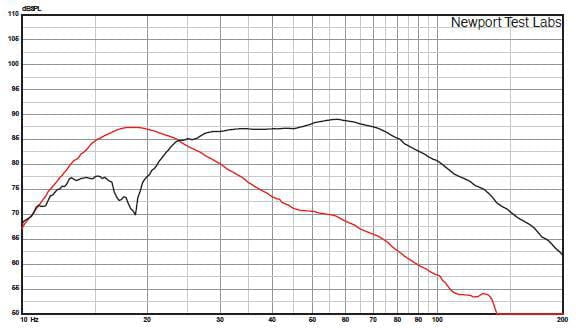
Graph 3 shows the set of near-field responses for the Klipsch SPL-150 that Newport Test Labs measured for various settings of the crossover control. You can see that the port’s output is very well-behaved at both minimum (solid red trace) and maximum (dashed red trace) of the crossover, though as you’d expect, there’s more high-frequency leakage from the port at the maximum setting.
The black trace on Graph 3 shows the frequency response of the driver when the crossover is set to 40Hz (minimum); the blue trace shows the response when the crossover is set to LFE, and the green trace shows the response when the crossover is set to the ‘12 o’clock’ position. These traces suggest to me that maybe Klipsch should have labelled the minimum setting on its crossover control as being 60Hz.
Newport Test Labs was not able to test the maximum sound pressure levels of which the SPL-150 might be capable (Klipsch claims a 122dBSPL) but it did confirm that this subwoofer is capable of delivering levels in excess of 110dBSPL at 40Hz without audible distortion, which will be far more than is required for any domestic application.
Overall, Newport Test Labs’ measurements of the Klipsch SPL-150 show that it’s capable of delivering seriously deep bass at seriously high sound pressure levels.










